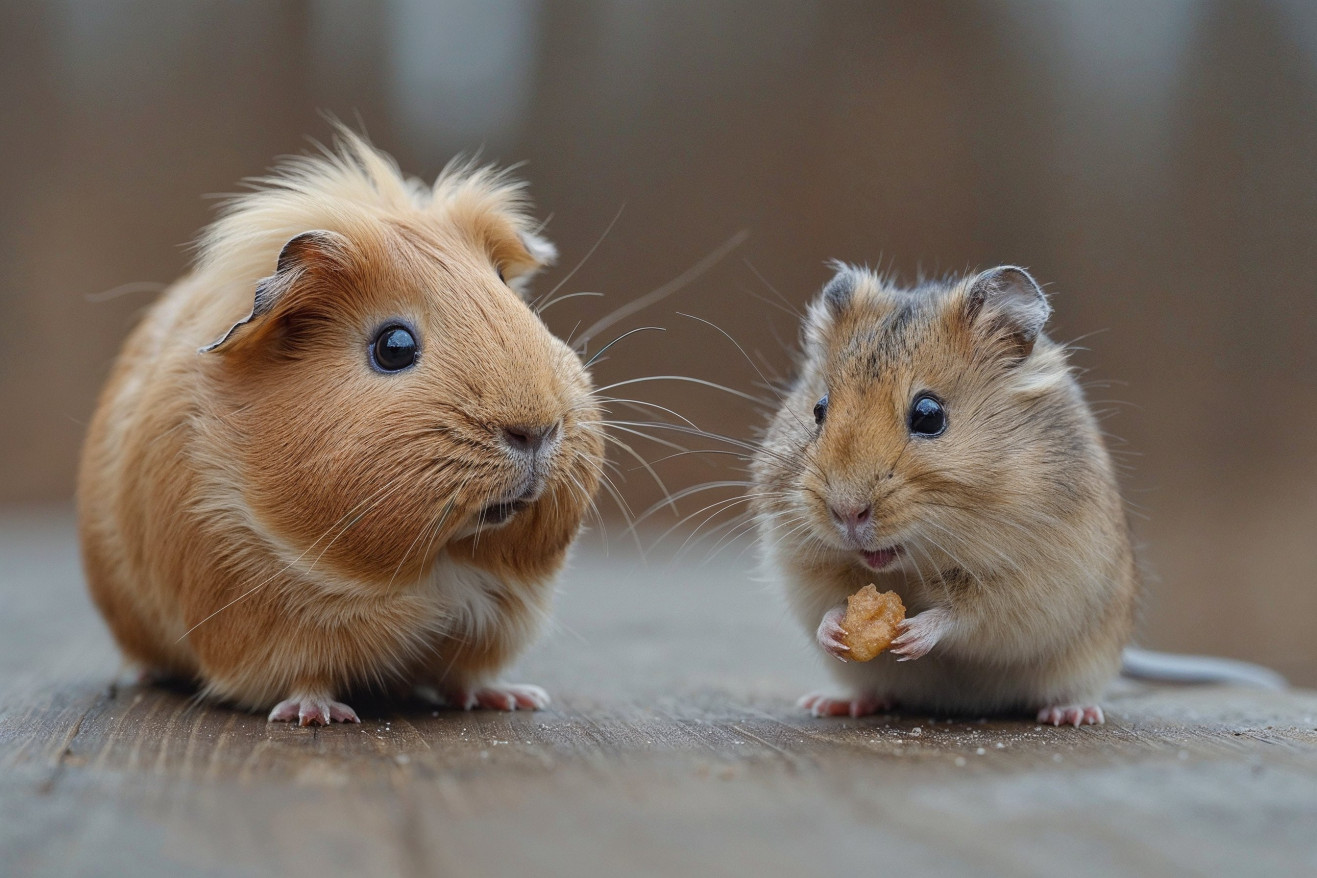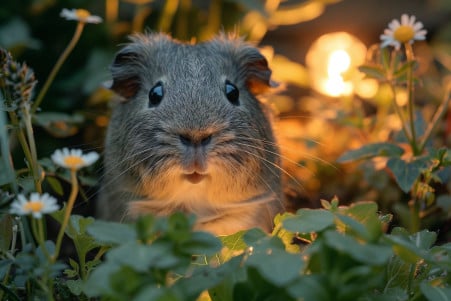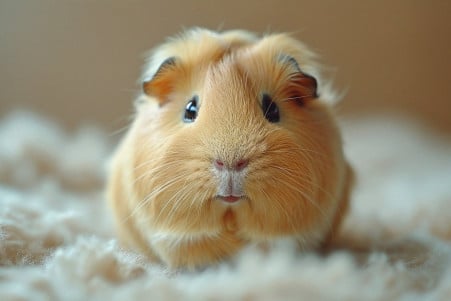Why Can’t Guinea Pigs Pick Up Food Like Hamsters? The Answer Lies in Anatomy
2 February 2024 • Updated 2 February 2024

Hamsters use their little hands to hold their food, but guinea pigs have a different way of getting their meals. It turns out that anatomical differences are the reason guinea pigs can’t pick up their food with their hands.
Guinea pigs have fewer, larger pads and less dexterity than hamsters, which means their hands are less adapted for grasping. These differences are a result of the animals’ natural foraging behavior and the way they move.
In this article, we’ll take a deep dive into a wide range of studies by animal behavior researchers and veterinary anatomists to find out why guinea pigs have evolved to eat in such a unique way. From research on the dexterity of limbs to information about evolutionary adaptations, we’ll look at how these things have contributed to the way guinea pigs eat.
In doing so, we hope to deepen your understanding of these animals and their unique behaviors.
What are the main reasons guinea pigs do not hold their food like hamsters when eating?
The Anatomical Structure of Guinea Pig Feet
The mystery of the guinea pig’s feeding behavior can be partially explained by the structure of their feet. Unlike other rodents, guinea pigs have feet with fewer and larger pads. This has a big impact on their ability to grasp, as Robyn Grant’s research showed.
The large pads are designed to absorb mechanical pressure, which suggests a sedentary, ground-dwelling lifestyle, rather than the manipulative ability of rats, who have many small, spaced-out pads that allow for more movement, as Grant’s 2019 research showed.
Using histology and electron microscopy, Robyn Grant’s research found that there is cartilage in the posterior pad of a guinea pig’s forepaw, which is likely there to reduce friction and compression when the animal is standing or moving. This is in keeping with their natural foraging behavior, which typically doesn’t involve using their paws to grasp food, and also with their mode of locomotion: short bursts to their burrows to escape predators.
This knowledge of their anatomy explains why guinea pigs would take a more static posture when feeding, using their feet less and other strategies more.
Behavioral Factors That Impact Guinea Pig Feeding Behavior
Looking at the behavioral tendencies of guinea pigs can help explain their unusual eating habits. In terms of social behavior, these animals are social foragers and eaters, according to VIER PFOTEN International.
This social lifestyle means that less importance is placed on the use of a single paw to feed and more on group behavior, which may help explain why guinea pigs don’t use their paws to eat.
In addition, Research by Marcelo H. Cassini shows that associative learning plays a role in guinea pigs’ feeding choices, as they learn to avoid tastes that have been associated with negative post-ingestive consequences like those caused by tannins.
Stress also plays a role in their feeding behavior. A study in ScienceDirect shows that guinea pigs eat less when humans are present and show more signs of stress when they can’t escape. This indicates that a sense of safety and freedom from stress are important to their normal feeding behavior.
The same study shows that human contact, especially in therapeutic situations, has a profound impact on their behavior, leading to a reduction in feeding when contact is made without an opportunity to escape.
These behavioral factors highlight the importance of environmental conditions and learned behaviors in guinea pigs’ feeding behavior, indicating that the relationship between instinct, learning, and stress and how they impact feeding behavior is quite complex.
Understanding the Neuromuscular Basis of Rodent Forelimb Dexterity
The dexterous forelimb movements that rodents use to handle food are the result of sophisticated neuromuscular control.
Guinea pigs have less dexterous forelimb movements than other rodents, and this difference may be due to differences in neuromuscular electrical stimulation and muscle contractions.
A study by Abbas in PubMed in 2009 found that neuromuscular electrical stimulation that improved movement in rodents with central nervous system injuries was most effective when it was applied to the muscles, showing that the relationship between neural inputs and muscle contractions is complex. This is especially important when considering that guinea pigs use their forelimbs less than other rodents.
In addition, the early relationship between nerves and muscle progenitors is important in the development of limb movement. A study by Duxson in PLOS ONE in 2015 found that the onset of primary myogenesis in rodent limbs is associated with this relationship, suggesting that it has a fundamental impact on later motor skills, including food handling.
Moreover, a study by Filous in Scientific Reports in 2019 investigated spinal motor neuron function in rats and found that it was associated with motor unit connectivity, which is important for the control of the limbs. This connectivity, which differs between species, may be a factor that limits guinea pigs’ forelimb use in food handling.
These neuromuscular differences may help explain the unique feeding behavior of guinea pigs and connect the anatomical and behavioral differences in the animals.
Evolutionary Signatures and Environment: Understanding Guinea Pig Eating Habits
A look at the evolutionary history of guinea pigs, which hail from the Andean regions of South America, shows that they have a very different past from the hamsters of the Palearctic region.
According to Wikipedia, ancestral guinea pigs lived in herds and ate mostly grasses, both of which are still true for their wild relatives today.
This social herding and the open meadows of the Andes are the opposite of the solitary, burrowing hamsters. According to ResearchGate, the risk of predation and the need for energy conservation are two of the most important factors that shape the foraging behavior of hamsters.
The guinea pigs’ evolution in the open, predator-filled meadows of the Andes likely led to an immobility response when threatened, which means that their feeding behavior is fast and doesn’t involve the use of the limbs, unlike the cheek-pouch-equipped hamsters that have evolved to gather and carry food, as the Animal Diversity Web explains in its entry on Cricetinae species.
These natural behaviors have been preserved in guinea pigs through domestication, which the Smithsonian National Zoo and Conservation Biology Institute says has led to their preference for living in groups and forming social structures.
While domestication has led to a variety of diets and living situations, the natural feeding behaviors of guinea pigs, including the scatter response to predators, are still present and show how their ancestors survived. This evolutionary history explains many of their unique eating habits and shows how they are a mix of their natural adaptations and their current care.
Why Don’t Guinea Pigs Use Their Paws to Eat?
To sum up, the question of why guinea pigs don’t use their paws to hold their food like hamsters is a complex one that involves anatomical, behavioral, neurological, and evolutionary factors. The size of guinea pigs’ paw pads and the reduced dexterity of their paws make it difficult for them to hold objects.
Meanwhile, guinea pigs’ foraging and social behaviors have evolved to avoid using their paws, instead favoring communal eating and stress reduction. Research on neuromuscular control has also shown that differences in limb movement and coordination impact guinea pigs’ ability to manipulate food.
Evolutionary history and environmental adaptation have also been key factors. The evolutionary lineage and environmental pressures have shaped guinea pigs’ feeding behaviors, leading them to eat quickly and without using their paws to reduce the risk of predation.
This knowledge is important not only for academic reasons but also for pet owners and researchers. By understanding guinea pigs’ inherent needs and behaviors, people can better care for them and gain a greater appreciation for the diversity of life on Earth. Armed with this information, pet owners can better meet the needs of their guinea pig pets in ways that are more in line with their natural behaviors, leading to happier, healthier animals.


